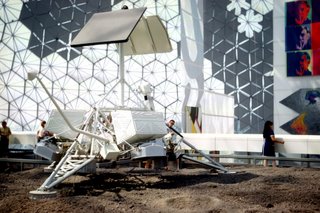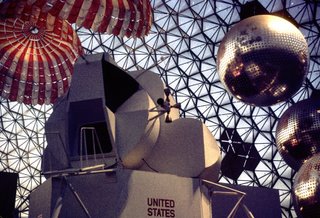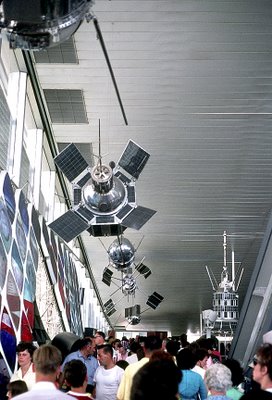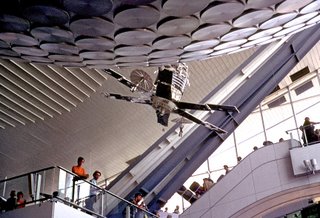The 1950's and 60's saw a general enthusiasm for space exploration, and by 1967 the U.S. and the USSR were engaged in a fierce race to put a man on the moon.
At Expo 67, both these countries attempted to convince visitors of their superiority in the field of space technology by featuring special space exhibits in their pavilions. These exhibits proved very popular and lineups were long...
The U.S. Space Observation Deck


 The U.S. pavilion used it's highest platform (9 stories high) for it's space exhibit entitled Destination Moon. The platform was reached by escalator, the longest one in existence in 1967 at 125 feet. Suspended from the ceiling of the pavilion were several actual Apollo and Gemini capsules (including the Freedom Seven Mercury capsule). A 3-man command module, and a model of the Surveyor space craft were also on display. The entire exhibit was enhanced by photographs, films of blast-offs and sounds of recorded conversations between astronauts, as well as models of space suits and examples of food used by astronauts.
The U.S. pavilion used it's highest platform (9 stories high) for it's space exhibit entitled Destination Moon. The platform was reached by escalator, the longest one in existence in 1967 at 125 feet. Suspended from the ceiling of the pavilion were several actual Apollo and Gemini capsules (including the Freedom Seven Mercury capsule). A 3-man command module, and a model of the Surveyor space craft were also on display. The entire exhibit was enhanced by photographs, films of blast-offs and sounds of recorded conversations between astronauts, as well as models of space suits and examples of food used by astronauts.
The USSR Space Gallery and Cosmos Hall


 Like their American counterparts, the USSR also placed their space gallery at the highest point of their pavilion's exhibition area. Several dozen sputnik models (each designed for a specific purpose) were suspened from the ceiling. Set on a backdrop of simulated surfaces of the moon and Venus was a fire-blackened model of Yuri Gagarin's space capsule. Cosmos Hall, a 60-seat spherical theatre in which visitors were taken on an imaginary journey to Mars, was very popular but required reservations...
Like their American counterparts, the USSR also placed their space gallery at the highest point of their pavilion's exhibition area. Several dozen sputnik models (each designed for a specific purpose) were suspened from the ceiling. Set on a backdrop of simulated surfaces of the moon and Venus was a fire-blackened model of Yuri Gagarin's space capsule. Cosmos Hall, a 60-seat spherical theatre in which visitors were taken on an imaginary journey to Mars, was very popular but required reservations...
History tells us that the the U.S. Apollo 11 space mission would eventually win the race, landing on the moon on July 20, 1969.
photos: FOS productions
At Expo 67, both these countries attempted to convince visitors of their superiority in the field of space technology by featuring special space exhibits in their pavilions. These exhibits proved very popular and lineups were long...
The U.S. Space Observation Deck


 The U.S. pavilion used it's highest platform (9 stories high) for it's space exhibit entitled Destination Moon. The platform was reached by escalator, the longest one in existence in 1967 at 125 feet. Suspended from the ceiling of the pavilion were several actual Apollo and Gemini capsules (including the Freedom Seven Mercury capsule). A 3-man command module, and a model of the Surveyor space craft were also on display. The entire exhibit was enhanced by photographs, films of blast-offs and sounds of recorded conversations between astronauts, as well as models of space suits and examples of food used by astronauts.
The U.S. pavilion used it's highest platform (9 stories high) for it's space exhibit entitled Destination Moon. The platform was reached by escalator, the longest one in existence in 1967 at 125 feet. Suspended from the ceiling of the pavilion were several actual Apollo and Gemini capsules (including the Freedom Seven Mercury capsule). A 3-man command module, and a model of the Surveyor space craft were also on display. The entire exhibit was enhanced by photographs, films of blast-offs and sounds of recorded conversations between astronauts, as well as models of space suits and examples of food used by astronauts.The USSR Space Gallery and Cosmos Hall


 Like their American counterparts, the USSR also placed their space gallery at the highest point of their pavilion's exhibition area. Several dozen sputnik models (each designed for a specific purpose) were suspened from the ceiling. Set on a backdrop of simulated surfaces of the moon and Venus was a fire-blackened model of Yuri Gagarin's space capsule. Cosmos Hall, a 60-seat spherical theatre in which visitors were taken on an imaginary journey to Mars, was very popular but required reservations...
Like their American counterparts, the USSR also placed their space gallery at the highest point of their pavilion's exhibition area. Several dozen sputnik models (each designed for a specific purpose) were suspened from the ceiling. Set on a backdrop of simulated surfaces of the moon and Venus was a fire-blackened model of Yuri Gagarin's space capsule. Cosmos Hall, a 60-seat spherical theatre in which visitors were taken on an imaginary journey to Mars, was very popular but required reservations...History tells us that the the U.S. Apollo 11 space mission would eventually win the race, landing on the moon on July 20, 1969.
photos: FOS productions
No comments:
Post a Comment